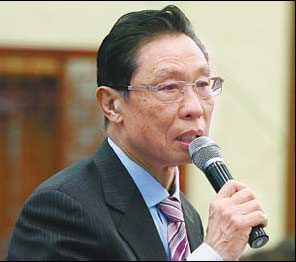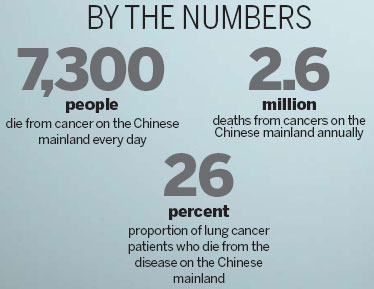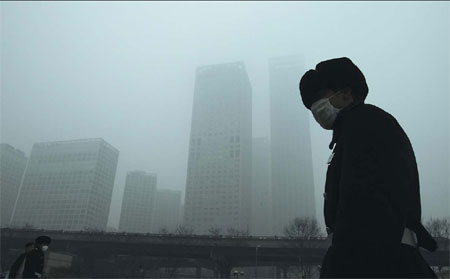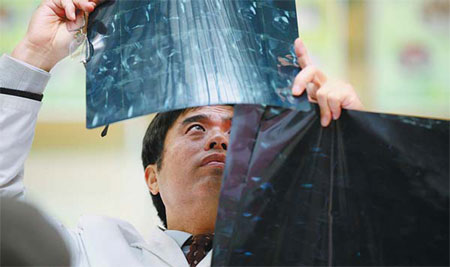A new environment emerges to tackle the problems of pollution
Updated: 2013-03-19 07:42
By Yang Wanli and Qiu Quanlin (China Daily)
|
||||||||
|
Beijing has been hit by severe smog and haze since early this year, prompting fears about the high levels of PM2.5. Wang Jing / China Daily |
|
Above: A doctor checks a lung X-ray at Gulou Hospital in Nanjing, capital of Jiangsu province. Below: Zhong Nanshan, a member of the Chinese Academy of Engineering, has warned that PM2.5 can cause tumors and lung cancer. Wang Xin / for China Daily |

Air quality becomes a hot topic amid threat of illness, report Yang Wanli and Qiu Quanlin.
Mei Baojiu, a Peking Opera singer, has displayed his passion for protecting traditional Chinese art forms during the past three years as a member of the Chinese People's Political Consultative Conference.
In 2010, he railed against modern interpretations of Peking Opera that mixed a number of different styles and "destroyed" the beauty of the traditional opera. In 2011, he encouraged theaters to raise the number of performances, and last year he suggested that "opera cartoons" should be made to encourage a greater understanding of the art form among the younger generation.
However, at this year's session of the CPPCC, Mei concentrated on a subject far removed from his field of expertise - air pollution. He said that poor air quality has damaged his voice. "My voice no longer sounds perfectly smooth and clear," he said.
However, for tens of millions of people across China who also suffer from high levels of PM2.5 - particulate matter smaller than 2.5 micrometers in diameter that can penetrate the lungs and harm the respiratory, cardiovascular, cerebrovascular and nervous systems - air pollution is not just about sore throats, but a matter of life or death. The World Health Organization considers a PM2.5 level of 25 micrograms per cubic meter to be a "safe" daily dose, but Beijing recorded levels of more than 900 on some days in January.
Zhong Nanshan, a deputy to the National People's Congress and a member of the Chinese Academy of Engineering, said recently that PM2.5 can cause tumors and lung cancer and therefore the rising levels pose an enormous risk to public health.
Citing research conducted by the American Association of Retired Persons over a period of 26 years, Zhong said haze and smog affect the nervous and respiratory systems and internal organs. The research indicated that every time the level of PM2.5 rises by 10 micrograms per cubic meter, the death rate from lung cancer rises by 15 to 27. Meanwhile, the number of viruses also increased by 20 percent when levels of PM2.5 increase by 10 mgs per cu m.
Zhong also quoted a study of 50,000 patients in Hong Kong that found a fatality rate of 11 percent among respiratory patients if the level of PM2.5 rose from 20 to 200 mgs per cu m.
The hot topic
Air pollution was one of the hottest topics at this year's meetings of the NPC and CPPCC. At least 20 deputies and members were reported to have made pointed speeches about the issue and criticism of air pollution is not groundless, said Zhong, because poor air quality is an important factor in both the incidence and cause of respiratory diseases.
When the concentration of PM2.5 rises by 10 mgs per cu m, hospitalizations may rise by as much as 3.1 percent, he said, citing research he helped to conduct in Hong Kong. Meanwhile, when the concentration of PM2.5 rises from 25 mgs per cu m to 200, the average daily fatality rate may soar to 11 percent.
Zhi Xiuyi, a leading expert in lung cancer treatment and also vice-president of the Chinese Association of Thoracic Surgeons, said medical authorities used to focus on tobacco control as a primary means of preventing lung cancer. "But in fact, air pollution is no less harmful than smoking and our research team released a report earlier this year that indicated that the cancer rate in Beijing is closely related to industrialization," he said.
The report, conducted by the Beijing Institute of Cancer Research, shows that the number of cancer patients in the Chinese capital has increased markedly during the past decade. Chaoyang district, the city's main area of industrialization, has the highest incidence of cancer, almost double that of Yanqing, an area on the outskirts of the city. Approximately four in every 1,000 Chaoyang residents have some form of the disease, with lung cancer at the top of the list.
"The risk of contracting cancer largely depends on the length of exposure and the concentration of noxious gases," said Zhi. In response to speculation that seven years' exposure to poor quality air will almost inevitably result in cancer, Zhi said the time scale was garnered from research overseas that suggested the rate of incidence generally peaked in the seventh year of exposure to a heavily polluted environment.
"But if one breathed in air with a PM2.5 level of between 200 to 300 five days a week, it might only take five years for the potential for cancer to rise to a dangerous level," he said.
Increased screening program
Experts believe cancer is caused by a number of factors, including the quality of water, food, lifestyle, atmosphere and also a genetic predisposition. "But the air is one of the factors with which we have contact every second of our lives," said Lin Yong, a physician at the respiratory department of Zhongda Hospital at Southeast University in Nanjing.
He said the lungs' capacity for self-purification is limited. "Working in an environment with a PM2.5 index of between 200 and 300 is tough on the lungs, not to mention breathing air with levels that are sometimes far in excess of that figure" he said.
Zhong said a growing number of people in large cities such as Beijing and Guangzhou, in Guangdong province, have contracted illnesses related to poor air quality, but argued that the outlook may not be as bleak as some observers imagine.
"It will not take 10 years for the air quality to improve. You can see that the air quality in Guangzhou improved drastically in 2010, when the city hosted the Asian Games. That was because tough anti-pollution measures have been in force there since 2006," he said.
"Cancer is not a disease that witnesses a significant increase or decrease because of changes in the environment or lifestyle," said Wang Ning, deputy director of the Beijing Institute of Cancer Research. He said the high incidence of cancer in Beijing will not decline markedly during the next decade.
"Lung cancer has a high death rate, as much as 90 percent, and the governments of the cities with the worst air pollution should take action as soon as possible," he said, stressing that more than 80 percent of lung cancer patients can be cured if the disease is diagnosed and treated at an early stage.
The Beijing health department will screen residents for the five main types of cancer, including lung, liver and colorectal, during the next five years. Meanwhile, educational cartoons will soon be shown on public transport to popularize preventive knowledge and the importance of early diagnosis.
Geographical challenges
Some areas face a greater challenge than others in the fight against air pollution. Yu Rucong, deputy director of the China Meteorological Administration, said geographic conditions and global climate change have combined to produce enormous difficulties for those seeking to improve air quality in East China.
He said severely smoggy days are the result of a number of factors - moisture and air pollutants, allied to stable atmospheric conditions. "The latter is beyond our control," he said. East China is the world's most prominent place for severe levels of smog, because of the hot, dry weather that spreads down the Yellow and Yangtze Rivers. Meanwhile, the lack of wind on the Qinghai-Tibet Plateau makes diffusion even harder.
"The climate is also changing in that wind speeds are slowing. Apart from that, rapid economic development and East China's current industrial mode also cause smog," he said.
During this month's Two Sessions, deputies and members offered advice and made suggestions to improve the atmosphere. Some urged that air quality be listed as an evaluation factor of government performances, while others said use of cleaner fuels should be compulsory to reduce pollution.
Huang Lianxi, a lawyer and member of the CPPCC, said the public has the right to know about cases of severe pollution and that the relevant laws should be strictly enforced. Heavy punishments should be meted out to those who transgress.
Pu Changsen, chairman of Shandong Energy Group, told the NPC that clean energy should be promoted nationwide, especially in Shandong province, where coal consumption accounts for approximately 10 percent of the national total. He stressed that the government should accelerate the replacement of coal-heating systems in North China with electric or gas heating.
Mahmoudi Artin, a pulmonologist and medical director of the intensive care unit at Beijing United Family Hospital, suggested that people should care more about air quality in their homes, as most people spend long periods indoors, especially during China's long, cold winters.
"Air purifiers and masks are two definite options. But it will be a long time before we see significant reductions in air pollution, so we need to pay more attention to the indoor environment, something that can easily be improved," he said. As an example, he urged people not to smoke indoors.
He also emphasized the importance of participating in outdoor sports, even on smoggy days. "The benefits more than outweigh the negative effects of the air pollution," he said.
Contact the writers at yangwanli@chinadaily.com.cn and qiuquanlin@chinadaily.com.cn
Mei Jia and Wu Wencong contributed to this story.

(China Daily 03/19/2013 page8)

 In Photos: 7.0-magnitude quake hits Sichuan
In Photos: 7.0-magnitude quake hits Sichuan
 Li Na on Time cover, makes influential 100 list
Li Na on Time cover, makes influential 100 list
 FBI releases photos of 2 Boston bombings suspects
FBI releases photos of 2 Boston bombings suspects
 World's wackiest hairstyles
World's wackiest hairstyles
 Sandstorms strike Northwest China
Sandstorms strike Northwest China
 Never-seen photos of Madonna on display
Never-seen photos of Madonna on display
 H7N9 outbreak linked to waterfowl migration
H7N9 outbreak linked to waterfowl migration
 Dozens feared dead in Texas plant blast
Dozens feared dead in Texas plant blast
Most Viewed
Editor's Picks

|

|

|

|

|

|
Today's Top News
Live report: 7.0-magnitude quake hits Sichuan, heavy casualties feared
Boston suspect cornered on boat
Cross-talk artist helps to spread the word
'Green' awareness levels drop in Beijing
Palace Museum spruces up
First couple on Time's list of most influential
H7N9 flu transmission studied
Trading channels 'need to broaden'
US Weekly

|

|









